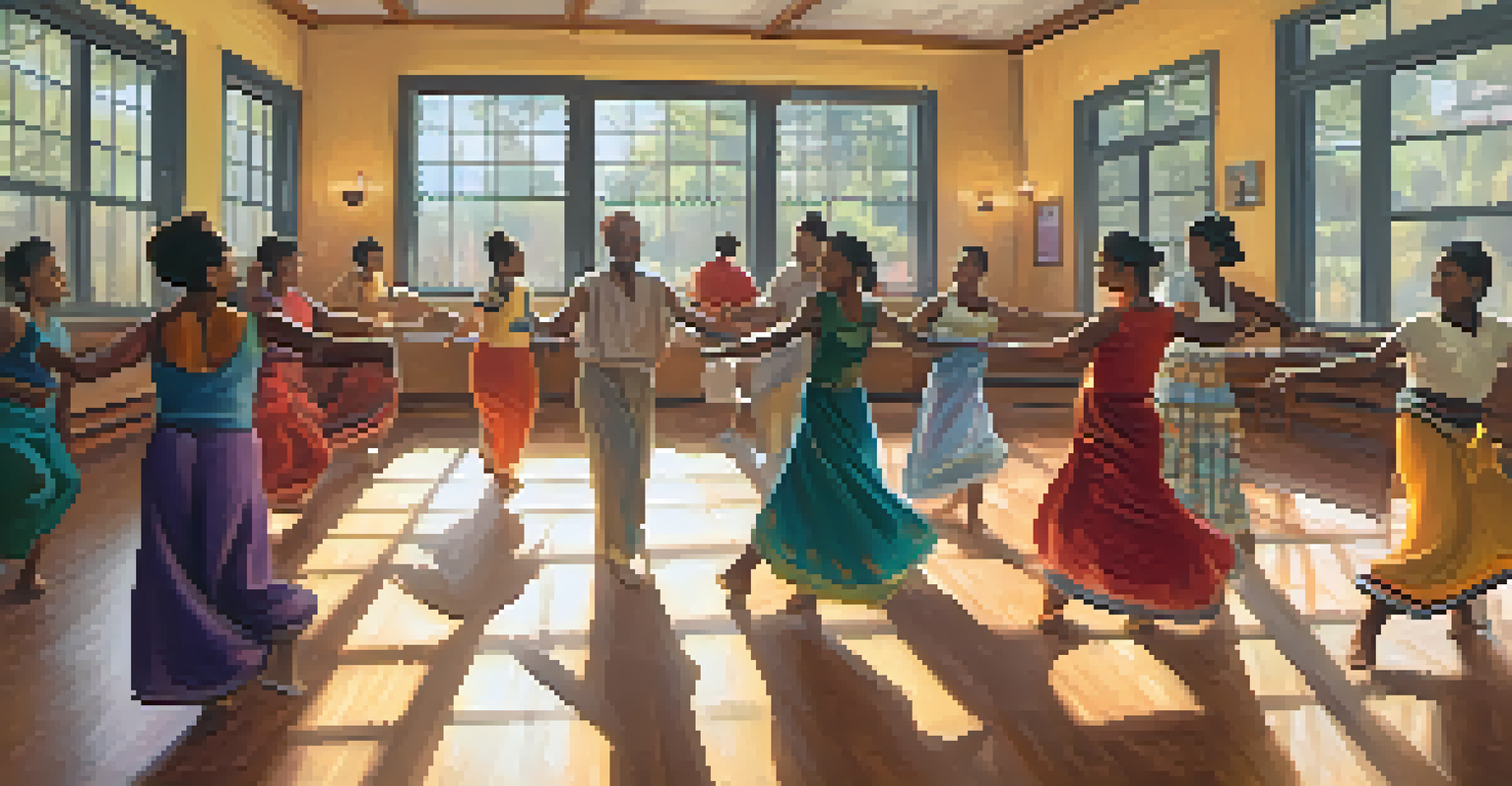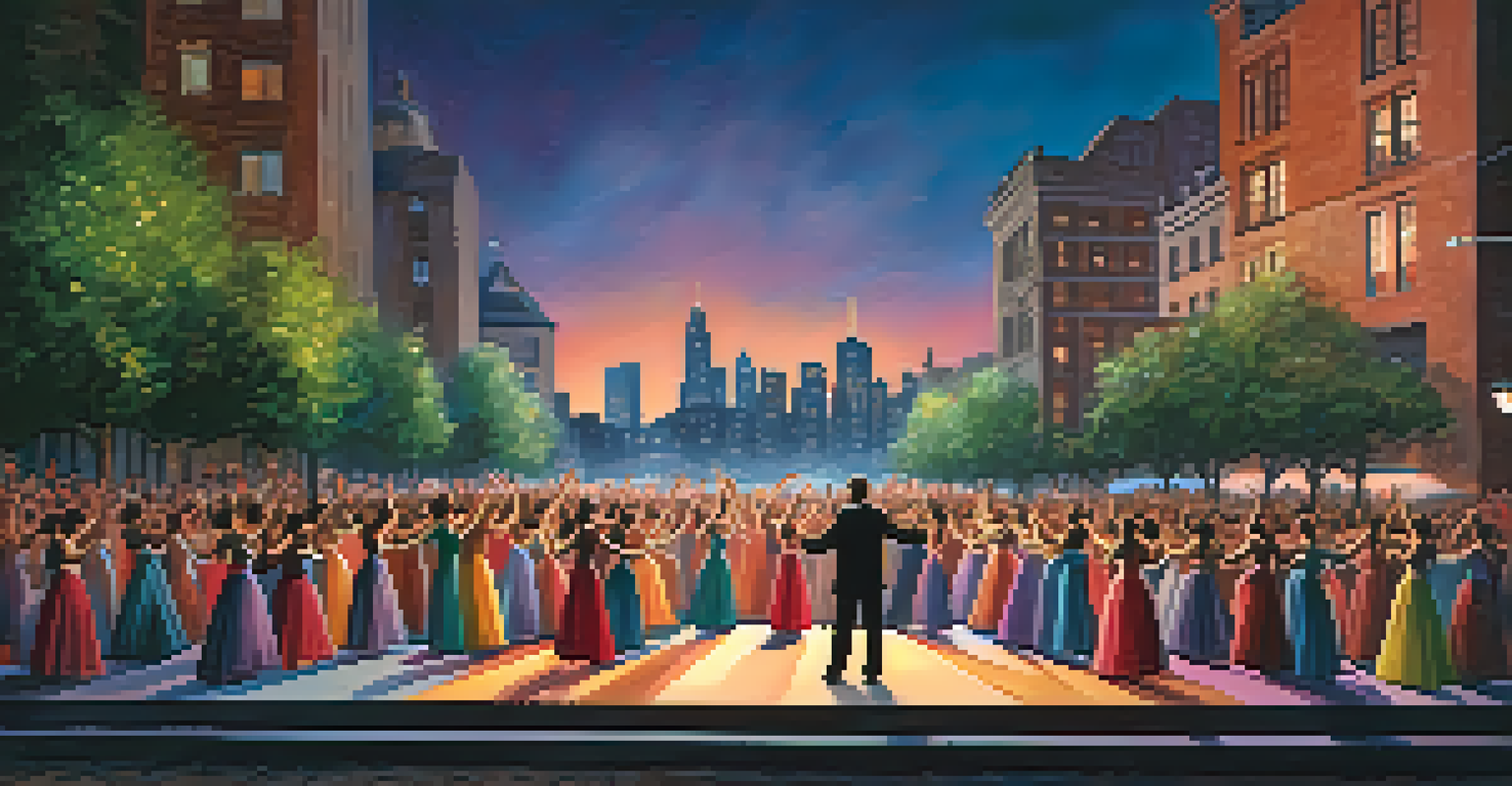The Influence of Dance on Urban Tourism Development

Understanding Urban Tourism: A Cultural Perspective
Urban tourism involves traveling to cities to experience their culture, attractions, and ambiance. It's not just about visiting landmarks; it's about immersing oneself in the local lifestyle. A key aspect of this lifestyle is the arts, particularly dance, which reflects the unique cultural identity of a place.
Dance is the hidden language of the soul.
Cities often leverage their cultural assets, including dance, to attract tourists. For instance, cities like New Orleans and Rio de Janeiro are famous for their vibrant dance scenes, drawing visitors eager to experience local traditions. This creates a symbiotic relationship where tourism helps preserve and promote these cultural expressions.
Moreover, urban tourism provides a platform for diverse dance forms, from traditional folk dances to contemporary styles. This variety enriches the cultural landscape of cities and offers tourists a chance to engage with the local community in meaningful ways.
Dance Festivals: Catalysts for Urban Tourism Growth
Dance festivals have emerged as powerful tools for boosting urban tourism. Events like the Edinburgh Festival Fringe or the Dance on the Pier in New York City attract thousands and showcase local and international talent. These festivals not only entertain but also educate attendees about different dance traditions.

By hosting dance festivals, cities can create a buzz that attracts not just locals but tourists from around the globe. This influx of visitors can significantly benefit local businesses, from hotels to restaurants, enhancing the overall economic impact of the event. It’s a win-win situation for everyone involved.
Dance Festivals Boost Urban Tourism
Dance festivals attract thousands of visitors, benefiting local businesses and promoting cultural exchange.
Furthermore, these festivals often promote cultural exchange, allowing tourists to interact with local dancers and participate in workshops. Such experiences create lasting memories and foster a deeper appreciation for the city's cultural heritage.
Dance as a Tool for Cultural Exchange in Tourism
Dance serves as a universal language, facilitating cultural exchange in urban tourism. Visitors often seek authentic experiences, and participating in local dance activities provides just that. Whether through classes, performances, or community events, dance allows tourists to connect with locals on a personal level.
Traveling – it leaves you speechless, then turns you into a storyteller.
Many cities have embraced this concept by offering dance tours, where tourists can learn traditional dances and understand their historical significance. This not only educates visitors but also promotes cultural pride among residents, creating a vibrant community atmosphere.
Additionally, dance can bridge gaps between diverse cultures. When tourists engage with local dances, they gain insights into the values and stories behind them, fostering respect and understanding across cultures.
The Economic Impact of Dance on Urban Tourism
The economic benefits of dance in urban tourism are substantial. Dance events and performances often drive tourism revenue, creating jobs in the hospitality, entertainment, and service sectors. This economic boost can be particularly impactful for smaller cities looking to increase their visibility.
Local governments recognize this potential and often invest in dance initiatives as part of their tourism strategies. By funding dance programs and events, they can attract more tourists and stimulate the local economy. This investment pays off as cities become more vibrant and appealing to visitors.
Dance Enhances Cultural Connections
Participating in local dance activities allows tourists to connect with the community and appreciate its heritage.
Moreover, the economic impact extends beyond immediate tourism revenue. Increased foot traffic from dance events can lead to long-term benefits for local businesses, as returning tourists spread the word about their experiences, encouraging even more visitors.
Dance Education: Cultivating Future Urban Tourists
Dance education plays a crucial role in nurturing future urban tourists. By introducing young people to various dance forms, cities can instill a sense of cultural appreciation that may inspire future visits. Schools and community centers often offer dance classes that celebrate local traditions, ensuring they remain alive and relevant.
Furthermore, educational programs can include field trips to performances or festivals, providing students with firsthand experiences of urban tourism. These opportunities can ignite a love for travel and cultural exploration, leading to a new generation of informed tourists.
As these young individuals grow, their experiences with dance can shape their travel choices. They are more likely to seek destinations rich in cultural experiences, further intertwining dance with urban tourism development.
Dance and Urban Identity: Strengthening Community Ties
Dance has the power to shape urban identity, fostering a sense of belonging among residents. When cities promote their dance heritage, they cultivate pride in their cultural narratives. This enhances community cohesion, making residents more invested in their city's tourism appeal.
Local dance groups often serve as ambassadors of culture, showcasing the vibrancy of their communities. Through performances and collaborations, they create bonds that resonate with both locals and visitors. This shared experience enriches the urban tourism landscape, inviting tourists to explore beyond the typical attractions.
Economic Benefits of Dance Events
Dance performances drive tourism revenue and create jobs, significantly impacting local economies.
Moreover, when tourists appreciate these community-driven dance expressions, they contribute to a more authentic tourism experience. This connection not only supports the local economy but also encourages a sustainable approach to tourism that benefits everyone involved.
Future Trends: The Evolution of Dance in Urban Tourism
As urban tourism continues to evolve, so does the role of dance within it. With the rise of social media and digital platforms, dance can reach a global audience, enticing tourists to visit cities celebrated for their dance scenes. Online dance challenges and viral trends can spark interest in a destination's cultural offerings.
Cities are also beginning to explore innovative collaborations between dance and technology. Augmented reality experiences or virtual dance performances can provide an immersive way for tourists to engage with local culture before they even arrive. This blend of technology and art opens new avenues for urban tourism.

Looking ahead, the integration of diverse dance styles will likely become more pronounced, reflecting a globalized world. Urban tourism will continue to leverage dance as a tool for connection, ensuring that cities remain vibrant cultural hubs.